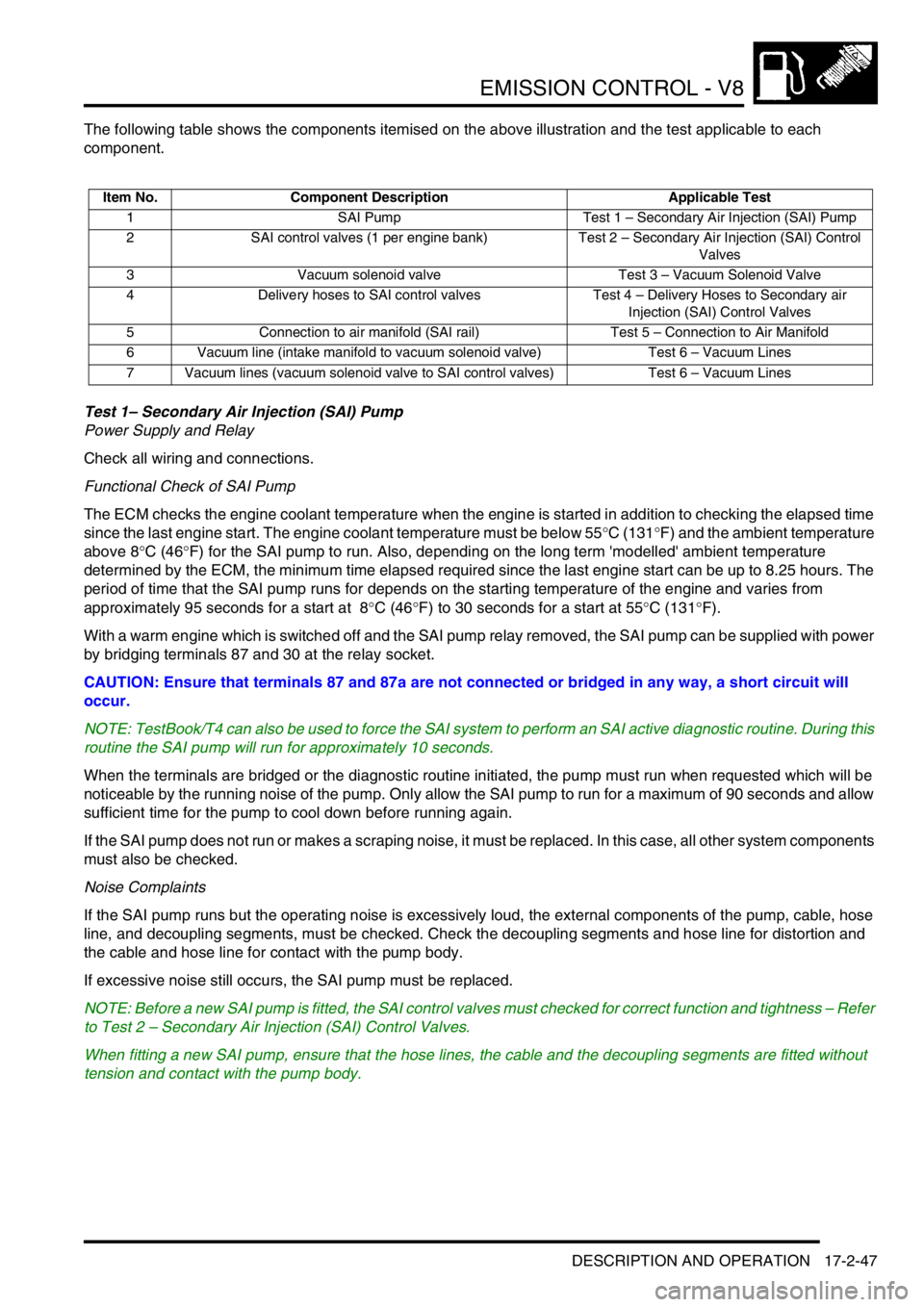engine LAND ROVER DISCOVERY 1999 Workshop Manual
[x] Cancel search | Manufacturer: LAND ROVER, Model Year: 1999, Model line: DISCOVERY, Model: LAND ROVER DISCOVERY 1999Pages: 1529, PDF Size: 34.8 MB
Page 280 of 1529

EMISSION CONTROL - V8
DESCRIPTION AND OPERATION 17-2-47
The following table shows the components itemised on the above illustration and the test applicable to each
component.
Test 1– Secondary Air Injection (SAI) Pump
Power Supply and Relay
Check all wiring and connections.
Functional Check of SAI Pump
The ECM checks the engine coolant temperature when the engine is started in addition to checking the elapsed time
since the last engine start. The engine coolant temperature must be below 55°C (131°F) and the ambient temperature
above 8°C (46°F) for the SAI pump to run. Also, depending on the long term 'modelled' ambient temperature
determined by the ECM, the minimum time elapsed required since the last engine start can be up to 8.25 hours. The
period of time that the SAI pump runs for depends on the starting temperature of the engine and varies from
approximately 95 seconds for a start at 8°C (46°F) to 30 seconds for a start at 55°C (131°F).
With a warm engine which is switched off and the SAI pump relay removed, the SAI pump can be supplied with power
by bridging terminals 87 and 30 at the relay socket.
CAUTION: Ensure that terminals 87 and 87a are not connected or bridged in any way, a short circuit will
occur.
NOTE: TestBook/T4 can also be used to force the SAI system to perform an SAI active diagnostic routine. During this
routine the SAI pump will run for approximately 10 seconds.
When the terminals are bridged or the diagnostic routine initiated, the pump must run when requested which will be
noticeable by the running noise of the pump. Only allow the SAI pump to run for a maximum of 90 seconds and allow
sufficient time for the pump to cool down before running again.
If the SAI pump does not run or makes a scraping noise, it must be replaced. In this case, all other system components
must also be checked.
Noise Complaints
If the SAI pump runs but the operating noise is excessively loud, the external components of the pump, cable, hose
line, and decoupling segments, must be checked. Check the decoupling segments and hose line for distortion and
the cable and hose line for contact with the pump body.
If excessive noise still occurs, the SAI pump must be replaced.
NOTE: Before a new SAI pump is fitted, the SAI control valves must checked for correct function and tightness – Refer
to Test 2 – Secondary Air Injection (SAI) Control Valves.
When fitting a new SAI pump, ensure that the hose lines, the cable and the decoupling segments are fitted without
tension and contact with the pump body.
Item No. Component Description Applicable Test
1 SAI Pump Test 1 – Secondary Air Injection (SAI) Pump
2 SAI control valves (1 per engine bank) Test 2 – Secondary Air Injection (SAI) Control
Valves
3 Vacuum solenoid valve Test 3 – Vacuum Solenoid Valve
4 Delivery hoses to SAI control valves Test 4 – Delivery Hoses to Secondary air
Injection (SAI) Control Valves
5 Connection to air manifold (SAI rail) Test 5 – Connection to Air Manifold
6 Vacuum line (intake manifold to vacuum solenoid valve) Test 6 – Vacuum Lines
7 Vacuum lines (vacuum solenoid valve to SAI control valves) Test 6 – Vacuum Lines
Page 282 of 1529

EMISSION CONTROL - V8
DESCRIPTION AND OPERATION 17-2-49
Test 3 – Vacuum Solenoid Valve
Function
The vacuum solenoid valve is energised for the duration of the secondary air injection. The valve is open when
energised, the intake manifold vacuum acts on the diaphragm of the SAI control valve and the control valve opens.
The solenoid valve is closed when de-energised.
Power Supply
Remove the harness connector from the vacuum solenoid valve and check the voltage between the connection
terminals. No voltage must be present at the connector after switching off the SAI pump.
Opening/Tightness
Disconnect the vacuum line at one of the SAI control valves and connect a hand vacuum pump to the line. With the
engine running at idle, a pressure difference of a minimum of 390 mbar (5.65 lbf/in
2) must measurable on the hand
vacuum pump gauge with the vacuum solenoid valve energised.
The vacuum solenoid valve must be sealed when de-energised. If the Opening/tightness test fails, replace the
vacuum solenoid valv.
Test 4 – Delivery Hoses to Secondary air Injection (SAI) Control Valves
Visually inspect the delivery hoses to the SAI control valves for damage or blockage. If damage, condensate or
deposits are found the delivery hoses must be replaced. Check the hoses for correct connection and leaks.
Test 5 – Connection to Air Manifold
Check the connection for leaks visually or by using a leak detection spray. Reseal the connection if necessary.
Test 6 – Vacuum Lines
Visually inspect the vacuum lines for damage. Check each line for leaks or blockages using the vacuum hand pump.
Check the lines for correct connection.
Page 293 of 1529

EMISSION CONTROL - V8
17-2-60 REPAIRS
Air Manifold - LH - Secondary Air
Injection (SAI)
$% 17.25.17
Remove
1.Remove SAI control valve.
+ EMISSION CONTROL - V8,
REPAIRS, Control Valve - Secondary Air
Injection (SAI).
2.Disconnect 2 air manifold unions from adapters
in cylinder head.
CAUTION: Take care that air manifold pipes
are not damaged during removal of union
nuts.
3.Remove 2 nuts securing air manifold bracket to
inlet manifold.
4.Remove air manifold.Refit
1.Clean air manifold and cylinder head adapters.
2.Apply a small amount of engine oil to top of air
manifold union nuts and around air manifold
pipes.
3.Position air manifold and finger tighten both
union nuts.
CAUTION: Finger tighten union nuts as far
as possible, damage to air manifold pipes or
adapters may result if this is not done.
4.Tighten air manifold unions to 25 Nm (18 lbf.ft).
CAUTION: Ensure that air manifold pipes
are not distorted during tightening
operation.
5.Fit nuts securing air manifold to inlet manifold
and tighten to 25 Nm (18 lbf.ft).
6.Fit SAI control valve.
+ EMISSION CONTROL - V8,
REPAIRS, Control Valve - Secondary Air
Injection (SAI).
M17 0234
4
3
2
2
Page 294 of 1529

EMISSION CONTROL - V8
REPAIRS 17-2-61
Air Manifold - RH - Secondary Air
Injection (SAI)
$% 17.25.18
Remove
1.Remove SAI control valve.
+ EMISSION CONTROL - V8,
REPAIRS, Control Valve - Secondary Air
Injection (SAI).
2.Remove heater feed pipe.
+ HEATING AND VENTILATION,
REPAIRS, Pipe - Heater - Feed.
3.Disconnect 2 air manifold unions from adapters
in cylinder head.
CAUTION: Take care that air manifold pipes
are not damaged during removal of union
nuts.
4.Remove nut securing air manifold bracket to
inlet manifold.
5.Remove air manifold.Refit
1.Clean air manifold and cylinder head adaptors.
2.Apply a small amount of engine oil to top of air
manifold union nuts and around air manifold
pipes.
3.Position air manifold and finger tighten both
union nuts.
CAUTION: Finger tighten union nuts as far
as possible, damage to air manifold pipes or
adapters may result if this is not done.
4.Tighten air manifold unions to 25 Nm (18 lbf.ft).
CAUTION: Ensure that air manifold pipes
are not distorted during tightening
operation.
5.Fit nut securing air manifold to inlet manifold
and tighten to 25 Nm (18 lbf.ft).
6.Fit heater feed pipe.
+ HEATING AND VENTILATION,
REPAIRS, Pipe - Heater - Feed.
7.Fit SAI control valve.
+ EMISSION CONTROL - V8,
REPAIRS, Control Valve - Secondary Air
Injection (SAI).
M17 0223
43
3
5
Page 296 of 1529

EMISSION CONTROL - V8
REPAIRS 17-2-63
8.Remove 2 nuts securing air injection pipe to air
intake plenum.
9.Release pipe from clip on rear of air intake
plenum.
10.Release 3 clips securing harness to engine bay
bulkhead.
11.Position container to collect any coolant
spillage.
12.Release clips securing heater hoses to heater.
13.Release hoses from heater.
14.With assistance, manoeuvre air injection pipe
from engine bay.Refit
1.With assistance, manoeuvre air injection pipe
into engine bay and secure onto clip at rear of
air intake plenum.
2.Connect heater hoses to heater and secure
with clips.
3.Reposition harness along engine bay bulkhead
and secure with clips.
4.Fit and tighten nuts securing air injection pipe to
air intake plenum.
5.Connect multiplug to SAI vacuum solenoid.
6.Connect air pump hose to air injection pipe and
secure with clip.
7.Connect LH and RH SAI control valve hoses to
air injection pipe and secure with clips.
8.Remove container.
9.Top up engine coolant.
+ MAINTENANCE, PROCEDURES,
Cooling system.
M17 0231
M17 0232
M17 0233
Page 300 of 1529

ENGINE MANAGEMENT SYSTEM - V8
DESCRIPTION AND OPERATION 18-2-1
ENGIN E MANAGEMENT SY STEM - V8 DESCRIPTION AND OPERAT ION
Engine management component
location - Passenger compartment
LHD illustrated
1Engine control module
2Diagnostic connector3Malfunction indication lamp
Page 301 of 1529

ENGINE MANAGEMENT SYSTEM - V8
18-2-2 DESCRIPTION AND OPERATION
Engine management component
location - Engine compartment
Page 302 of 1529

ENGINE MANAGEMENT SYSTEM - V8
DESCRIPTION AND OPERATION 18-2-3
1Mass air flow/ inlet air temperature sensor
2Fuel injectors
3High tension leads/spark plugs
4Fuel pump relay
5ATC compressor clutch relay/ cooling fan relay
6Throttle position sensor
7Heated oxygen sensor
8Idle air control valve
9Ignition coils
10Engine coolant temperature sensor
11Crankshaft speed and position sensor
12Knock sensor
13Camshaft position sensor
Page 303 of 1529

ENGINE MANAGEMENT SYSTEM - V8
18-2-4 DESCRIPTION AND OPERATION
Engine management block diagram
Page 304 of 1529

ENGINE MANAGEMENT SYSTEM - V8
DESCRIPTION AND OPERATION 18-2-5
1Engine control module
2Crankshaft speed and position sensor
3Camshaft position sensor
4Engine coolant temperature sensor
5Mass air flow/ inlet air temperature sensor
6Throttle position sensor
7Heated oxygen sensors
8Fuel injectors
9Idle air control valve
10Fuel pump relay
11EVAP canister
12EVAP canister vent valve
13EVAP canister purge valve
14Fuel tank pressure sensor15Ignition coils
16Knock sensor
17Spark plugs
18High/ Low ratio switch
19Malfunction indication lamp
20Diagnostic connector
21Air temperature control clutch relay
22Air temperature control cooling fan relay
23ATC ECU
24CAN link to EAT
25SLABS ECU
26BCU
27Instrument cluster
28Thermostat monitoring sensor (where fitted)